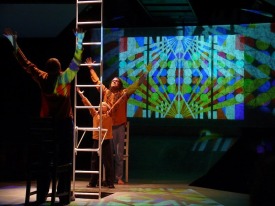Literary Art

The Hole in the universe
Stands—
before the mind.
Oranges,
in a napkin—
before You think
of "I" and "thing".
The Shape of the Room—
when eyes are closed.
—Adi Da Samraj
As with visual art, Adi Da Samraj also developed the artistic media of literature and theatre to communicate the nature of Reality Itself, and to illustrate the patterns and archetypes that tend to define people’s conscious participation in Reality Itself.
His literary masterwork is a multi-volume work entitled The Orpheum — comprising The Mummery Book (which He first wrote in the 1960s, and brought to fullness in the 1990s), The Scapegoat Book (written in 2005), and The Happenine Book (written in 2006).
In The Orpheum trilogy, Adi Da presents “a parable of the human heart”, in a work of deeply evocative archetypal drama. It is the story of “Raymond Darling’s” unique journey, simultaneously a literary allegory of His own human life, and an illustration of how the collective of human egos make a mockery of Reality Itself by trying to capture and control It. The story of The Orpheum trilogy is exquisitely poetic, truly humorous, wildly erotic, piercingly satirical, and devastatingly tragic. Finally, it is also the illumined restoration of Raymond Darling to his Divine Condition.
In the late 1990s, poet Robert Lax said of The Mummery Book (the opening volume of The Orpheum trilogy), “Living and working as a writer for many decades, I have not encountered a book like this, that mysteriously and unselfconsciously conveys so much of the Unspeakable Reality.”
The Orpheum is also presented in theatrical form. The primary theatre is located in Middletown, California, a two-and-a–half hour drive north from San Francisco.

